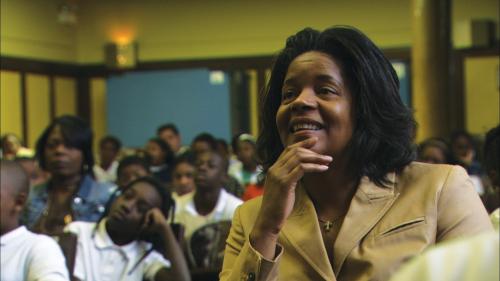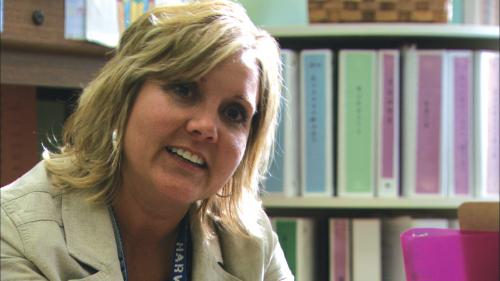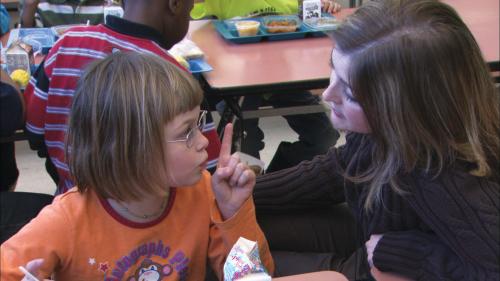
Adventures in the Screen Trade: Filmmaking 101 for an Engaged Funder
By Jessica Schwartz of The Wallace Foundation

In 2007, The Wallace Foundation commissioned a documentary film to look at the crucial role of principals in turning around low-achieving schools and raising student achievement. As of this month [April 2009], a one-hour documentary, The Principal Story, has just been completed; it has been selected by P.O.V., one of PBS’s premier documentary venues, to be broadcast on September 15, 2009. A national outreach campaign has also been launched, an outreach DVD/CD is now in production, and eight national association partners and 18 local public television stations are engaged.


The Principal Story follows two principals – one a veteran principal of an elementary school in Springfield, Illinois; the other, a rookie principal of a pre-K-8 school in Chicago – through a school year. These two stories allow us to see the real job of today’s principal, with all its competing pressures, challenges and rewards. Though both schools are high-poverty and historically low-performing, under their respective leaders they are making noteworthy progress.
Part of our selection process was to find talented filmmakers who could make sense of complex education issues and still tell a compelling story. Through a competitive process, we selected an award-winning documentary team – Tod Lending and David Mrazek of the Chicago-based Nomadic Pictures – to produce the film and secure a broadcaster. They in turn brought on Outreach Extensions (OE), a Los Angeles-based media outreach firm, to launch an outreach campaign that uses the film and related video to provoke dialogue, connect audiences to additional knowledge resources and encourage needed changes in policy and practice.
For the outreach campaign, a Wallace-hosted website and a DVD/CD package contain film clips, video segments and accompanying discussion guides that target different audiences. For example, an Executive Video for Policymakers, including interviews with education and policy experts, is aimed at state and district leaders who create leadership policies and allocate funding. A “mini-doc” on a high school principal will engage educators grappling with the specific challenges of different grade levels. A series of “video vignettes” of innovative leadership practices from around the country will be of interest to those training and mentoring school leaders.
Local public television stations competed for small grants to produce additional programming and conduct local educational outreach. National outreach partners, including associations that reach governors, state legislators, district superintendents and school principals, to name a few, are hosting screening events and panel discussions to engage their member constituency groups. Finally, this October, we are planning our own screening event at our national conference for 500 opinion leaders in Washington, D.C.
How did we get here?
Once the filmmakers were selected and our recommendation for full funding was approved by our Board in October 2007, Tod and David were given the green light to start the project. From the beginning, we formed an open line of two-way communication and, we like to think, a level of trust. We saw it as our responsibility to orient the filmmakers, both non-educators, to an emerging body of knowledge on effective school leadership, with significant resources on our website. While we provided these resources, they considered what among them might be helpful as they became involved in the filmmaking process. Along with the outreach partners, we recommended advisors from several levels of the education system, including state and district leaders, researchers and other education experts. These savvy pros presented them with multiple perspectives, in addition to those of the foundation.
Once the film was in production, Tod and David informed us of any significant changes, especially those that veered from their original proposal. Most are well documented in Tod’s personal statement, which is included in the outreach materials, but I will give one example that demonstrates our give-and-take relationship. Tod made a decision to cut from the film a third story on a high school principal; despite original intentions, he felt they could not do justice to three interwoven stories. While we trusted his judgment, we knew that educators were focused on high school improvement and that omitting this story would be a missed opportunity. Tod agreed and decided to create a separate “mini-doc” on Chicago’s North Grand High School principal.
While we were hands-off on the film, we have been active partners with Outreach Extensions on developing the outreach campaign. Our first joint decision was for Wallace to host the main film website (in addition to the P.O.V. site). Since the Wallace site serves as a knowledge hub – offering free downloads of publications and other resources produced or commissioned by Wallace – it made sense to house the outreach material there as well. This would ensure a long shelf life for the video and print resources and would link them to other knowledge sources. If the film raises viewers’ interest in, say, principal mentoring, we could link them to a Wallace publication on this topic. The other reason was simply economics: the cost of building and maintaining a new site was prohibitive. To take a peek at the newly launched site – and view a promo of the film – check out www.wallacefoundation.org/principalstory.
 Without Outreach Extensions, we would not have known how to leverage local public television stations as active partners in producing additional programming and connecting with their communities. OE worked with the stations, while we identified key spokespeople through our network of funded states and districts in many of the priority markets. We have helped OE shape the station outreach toolkit, and we work with the national outreach partners so that their activities complement what we are doing.
Without Outreach Extensions, we would not have known how to leverage local public television stations as active partners in producing additional programming and connecting with their communities. OE worked with the stations, while we identified key spokespeople through our network of funded states and districts in many of the priority markets. We have helped OE shape the station outreach toolkit, and we work with the national outreach partners so that their activities complement what we are doing.
Lessons learned
I’ve called this article “Filmmaking 101 for Engaged Funders” because, as the lead Wallace contact on the project, I was learning as I went. I would be asked questions that I wasn’t sure how to answer. In my dealings with the filmmakers, I was calibrating what was interference and what information was useful to them. I wanted to ensure that any comments or suggestions regarding advisors or resources were taken as helpful and not as directives from the funder. In thinking back over the past year, I’ve learned a few lessons:
1. Involve colleagues at every turn
Involving Wallace staff at critical moments during the process has been important to the foundation’s embracing of this project. In particular, I was helped at every stage by Frederick Brown, senior education program officer, whose expertise in education was invaluable to the filmmakers. Tod and David invited several of us from Wallace to join a screening of the rough-cut version, along with some central office staff from Chicago Public Schools. The discussion that followed was lively – I admired the filmmakers’ openness to many comments – but, more importantly, seeing the film at this early stage gave the foundation the confidence that there were several of us who recognized the quality and utility of this film to meet our goals for the project.
2. Get in front of all potential issues
While we did not interfere with the selection of schools and principals, we should have suggested that the filmmakers connect with each district’s superintendent and others in central offices earlier in the process. There were some delays and miscommunications as a result that could have been avoided. Based on our grantee contacts, the foundation was in a position to make some introductions. Finally, a point that will lead to the next lesson: it’s never too early to start the planning for the outreach campaign.
3. Understand what goes into an outreach campaign and be prepared to fund it
While I recognized the great opportunity to engage targeted audiences through an outreach campaign, I was slow to realize the amount of new production and writing that this required. National outreach partners would need to do more than screen and disseminate the film; they would need written materials to guide discussions, draw out implications and, hopefully, spur action. We thus gave an additional grant, as one example, to the National Staff Development Council (NSDC) to develop The Principal Story Field Book for principal trainers and mentors. Because of our long planning cycle, we asked NSDC to develop a grant proposal in time to be approved at our October 2008 Board meeting. This publication will be part of the film website and outreach DVD/CD.
4. Trust the creative process and share knowledge
As already mentioned, Wallace was interested in presenting a balanced picture of leadership, based on credible and reliable sources, as vital to enduring school reform. Yet we were aware that aspects of our leadership work – the role of the state and district in training and supporting high-quality leaders, for example – might be difficult to capture in a dramatic medium. To get the quality project we sought, we needed both to trust in the creative process and to share what we were learning about education leadership with the filmmakers. Tod and David did not start out as education experts, but they soon came to appreciate the pivotal, complex role of the school leader. As Tod wrote in his personal statement, “In making this film, I learned that it takes a tremendous amount of passion, love and ‘heart-work’ to be a good principal. It was inspiring to film the three amazing principals that we followed.”
So far, this has been a terrific collaboration: the filmmakers creating a powerful documentary, Outreach Extensions guiding a comprehensive, national outreach campaign, and Wallace offering not just funding, but an emerging body of credible knowledge on effective school leadership.
The next cycle of work will be the public phase: a film is broadcast, events are held, and, we hope, the national discourse on education turns its attention to leadership at a time when it’s sorely needed to improve our nation’s schools.
__________________________________________
Jessica Schwartz is Senior Communications Officer at The Wallace Foundation. She will occasionally check in with updates on her foundation’s Adventures in the Screen Trade. Among the top 40 private U.S. foundations with assets of more than $1.7 billion, The Wallace Foundation strives to be a “knowledge center” for policymakers and practitioners in its three areas of focus: building appreciation and demand for the arts; improving after-school learning opportunities; and strengthening education leadership to improve student achievement. The approach common to all areas of their work is to support innovation, gather credible lessons about what works and what does not, and then share those lessons broadly with the field.
The Filmmakers: Nomadic Pictures. Tod Lending and David Mrazek are both award-winning film producers, directors and writers. Lending’s feature documentary, Legacy, tells the story of how a family, over a five-year period, recovered from the tragic death of a young boy, broke free of welfare, overcame addiction and escaped their violent community. It was a critical success at the Sundance Film Festival, was nominated for an Academy Award in 2000 and aired on both Cinemax/HBO and PBS. Lending next directed Omar & Pete, which followed two African-American men’s struggles after their releases from prison. He also wrote, produced and directed the award-winning No Time to Be a Child, a three-part documentary series, co-produced with Detroit Public Television. He is the recipient of numerous awards, including a national Emmy for Outstanding Children’s Special, A Casey Medal for Meritorious Journalism, the CINE Gold Eagle, Golden Apple, the New York Festival World Medal and the Innovation in Documentary Award. Mrazek was series producer and co-writer of The Kingdom of David: The Saga of the Israelites, a four-hour nationally broadcast PBS series filmed on location in Israel, Tunisia, Morocco and Greece. He has produced and co-written two programs for the PBS American Experience series: The Duel, on dueling as an eighteenth-century political tool (and the story of Hamilton and Burr); and Woodrow Wilson, on the transformation of a history professor into a great president.
Outreach Providers: The Los-Angeles based firm Outreach Extensions has more than 14 years of experience in developing and implementing solution-based outreach campaigns in association with media projects. The Principal Story project will benefit from the long-term collaboration between Nomadic Pictures and Outreach Extensions on projects including Legacy, Omar & Pete, Roosevelt’s America and the No Time to Be a Child series. Other recent campaigns designed and managed by Outreach Extensions include Eyes on the Prize, Prayer in America, and Critical Condition.


